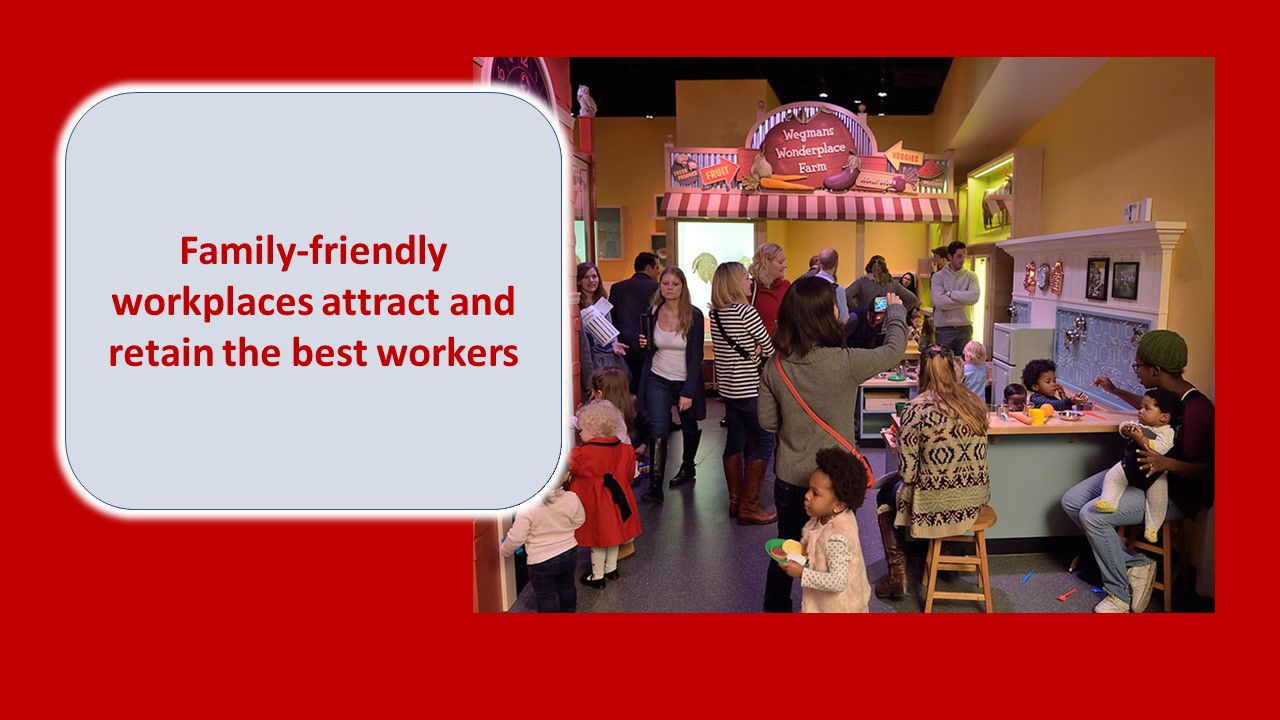By Thomas Davis, CRNA, MAE, DNAP candidate.
The United States is currently experiencing economic growth that has created a record low unemployment rate and increased the competition for skilled and motivated employees. The 2016 census reports that 32% of the active workforce have children (per: Bureau of Statistics). Among those who have graduated from college in the past 20 years are men and women with advanced degrees who are eager to participate in the workforce but must balance the demands of the job with the responsibility of raising children or caring for elderly parents. In order to capitalize on the talents of those who wish to work, corporations are taking steps to make the workplace more friendly for those with family obligations. The intent is to attract highly qualified people to join their team and to provide incentives to retain those already filling key positions.
Every year Fortune magazine posts its list of the 100 Best Workplaces in America and, no surprise, those at the top are known for their family friendly approach to developing human resources. This year, Wegman’s, a food market headquartered in New York, moved into the #2 position on the list partly because they offer many perks to help those who are juggling career and family. Wegman’s management puts an emphasis on building a preferred workplace for every employee and then provides incentives that boost their family-friendly rating. Special benefits offered by Wegman’s include lactation rooms, fertility treatment, and paid leave to care for a sick child. Family-friendly at Wegman’s includes measures to make the store kid-friendly for customers. The store in St. Louis boasts of 15 kid-friendly features in their store.
A blog posted on care@work rates Edward Jones as #5 on the short list of top ten family-friendly employers. At EJ, families can opt for a baseball tickets overnight family retreats at company expense. And new moms “can take up to 120 paid days off for maternity leave.”
Attracting and retaining highly skilled workers is just as important in healthcare as it is at the supermarket. Like the workers on Main street, many who work in healthcare must balance personal and professional lives using multi-dimensional equilibrium that ensures quality patient care and meets personal family needs. Frontline healthcare team leaders are seldom able to implement sweeping changes in corporate benefits; however, there are things that they can do to make an individual workgroup more family friendly.
- Listen and connect. Connecting with team members on a personal level is a key element of good leadership and is especially important when building a family friendly workplace. Take an interest in things that are important to those you supervise and learn the names, ages and interests of their children. Be sensitive to the coordination that the worker must do daily to ensure that children are able to attend activities, eat meals, do schoolwork and keep a reasonable sleep schedule. Having empathy will elevate your understanding of the workers needs and open your eyes to ways to help the person meet his/her obligations.
- Flexible time. When it comes to a work schedule, one size does not always fit all. Workers coordinate with their partners for delivery and pick-up of children and the timing may not always fit your traditional schedule. For example, Ana is a valuable team member but can not deliver children to school and be at work promptly at 7am. Her creative manager shifted Ana’s work schedule to have her arrive at 8am and then be the person to stay an hour later than the others in the afternoon. With the flexible schedule, Ana’s needs are met, and the workplace has a reliable person who ensures the afternoon shut-down process is done correctly.
- Job sharing. All-star workers who have just become moms may not have the stamina to work full time and meet home obligations. Rather than losing highly effective workers, offer the opportunity other team players to combine and cover one full time position collectively. For example, at our workplace a young mom-to-be does not want to quit her job, nor does she feel able to work full time and care for her baby. Another person on the team who is toward the end of her career feels the need to cut back and work only a few days per week. Encouraging them share a position retains skilled workers and leaves the manager with one position to fill rather than two.
- Switch to part time. Building a flexible part time schedule for a worker whom you don’t want to lose is another key to maintaining a cohesive team. Often, the request to convert to part time comes from a worker who has obligations caring for an elderly parent, or grandchildren or who has earned his stripes and wants to cut back. Accommodating the cut-back request sends a message that you value the person and want him/her on the team, even if only part time.
- Remote work. Although working from home is not possible for a person delivering hands-on care, there are behind-the-scenes jobs that do not require the person to physically be at the workplace. For example, a busy GI center makes two pre-procedure calls to each patient to ensure that they understand the bowel prep and know when and where to report the day of the procedure. In addition, every post procedure patient receives a phone call. The process requires two nurses to spend the entire day on the phone; calls that could be made from home just as easily as from the GI center. Other tasks such as ordering supplies, building work schedules or revising policies/procedures could also be done from a home computer.
- Healthy family days. Think beyond the traditional workday and offer family friendly days for healthy activities. Schedule a Saturday morning day at the playground or a Sunday afternoon picnic in the park and have activities for children of all ages. Adults will network, children will play, and a fun time will be had by all.
Does family-friendly matter? Ask a colleague who has been challenged with a special family need. Those who were supported by their employer feel a bond of loyalty with the organization and become highly committed to the job. In contrast, those who were treated as #1 Nuisance feel no loyalty and become disgruntled employees. Here are a few examples that I have personally witnessed:
- An anesthesiologist friend of mine reinforced the importance of supporting family needs by sharing the story that his wife required 6 weeks of bedrest prior to the delivery of their first child. His employer told him immediately that his wife was his top priority and that the team would work around whatever schedule was needed to accommodate his wife’s care. Following a successful delivery of a healthy baby, he is a loyal employee who continues to sing praises for the employer.
- A member of our small perioperative team had a child with a special event at school at 7:30am. All members of the team agreed to start the room at 10am that day and stay late if needed to complete cases.
- A member of our team suffered a severe burn that required ICU and follow-up surgery. He was on the low end of the pay scale and could not afford his $5000 medical deductible. The team rallied and in short order raised the required money to ensure that our colleague received the best possible care.
Teams that go the extra mile to take care of colleagues with family needs are rewarded with a team member who is totally committed to the group and ready to step in when others are in need. The return on investment is high.
When it comes right down to it, blood is thicker than water. Water is important, of course. It nourishes the family, even makes the family possible. But, as a leader, never forget that family will always be the first concern of all workers; the reason they work extra hours when needed, the reason they agree to imperfect contracts, and the reason they are loyal to a family-friendly workplace. When you hire a worker, you are hiring his/her family and it behooves you and the entire healthcare industry to listen, to learn and to lead accordingly. The time and effort that you put into creating a family friendly workplace will reap benefits for decades into the future.
Tom is a noted author, enthusiastic speaker, committed leadership developer and superb clinical anesthetist. Contact tom@prosynex.com to book a speaking engagement.



